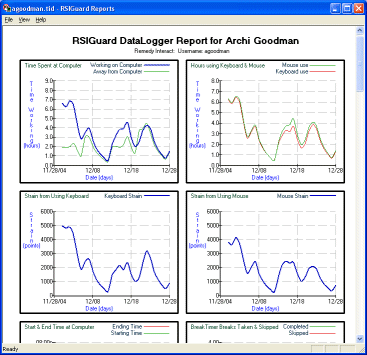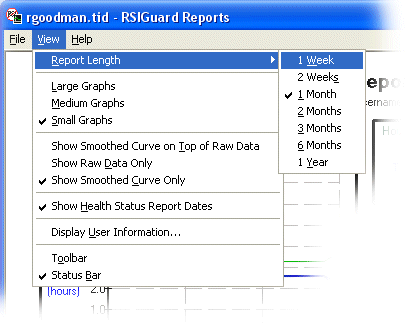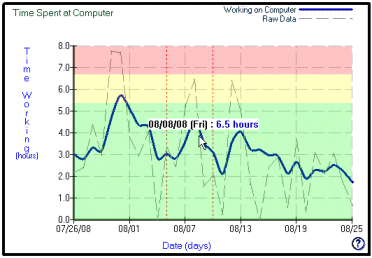RSIGuard Reports
What is the DataLogger and RSIGuard Reports?
The DataLogger feature of RSIGuard constantly records ergonomic usage data such as how many hours you spend on the computer, how often you take suggested breaks, and how you use the mouse and keyboard. RSIGuard typically stores this data on your hard drive (or a network drive it your company has configured network storage).
To view the data you use RSIGuard's companion program, "RSIGuard Reports". You can run RSIGuard Reports either by:
- clicking on the Tools menu of RSIGuard, clicking on DataLogger Usage Statistics and selecting View Longterm Usage Statistics (recommended)
or
- clicking on the Windows Start menu, clicking on Programs, selecting RSIGuard, and then clicking on "RSIGuard Reports"
You will see a window like this one:

RSIGuard Reports Display Options
If you start RSIGuard Reports from RSIGuard (via "View Longterm Usage Statistics") RSIGuard will automatically open your usage data file. If you open RSIGuard from the Start menu, you'll need to click File/Open and browse to your data file.

From the View menu, you can specify what data you wish to view and how you want to see it:
- Report Length - Select the range of data you wish to view 1 week to 1 year. (You can view data older than 1 year by clicking File/Open and selecting the data from the desired year).
- Graph Size - Select the desired size of graphs (large, medium or small).
- Data Representation - Select whether you wish to see the raw data, a smoothed version of the graph, or a smooth graph superimposed on top of the raw data. Raw data means the actual values. Smoothed data shows a line that averages values and therefore makes it easier to see trends.
- Health Status Reports Markings - Select whether you wish to see markings that show dates on which you filed Health Status Reports or DataLogger Status Reports. Double-clicking on these marks will show you the reports that were filed using the Health Status Reports Tool.
- Display User Information - Shows additional user information stored in this file.
If you wish to see the precise value of a statistic on a particular day, just move the mouse over that graph and the statistic will be displayed.

Printing Reports
After selecting the viewing options you want, you can print the DataLogger graphs. Click on File and select Print (or Print Preview). You can also click on the Printer icon in the toolbar or press "Ctrl P". The print window will allow you to either print selected pages of the reports or the entire report.
Exporting DataLogger Data
You can export you DataLogger data to CSV format which is directly importable into any database or spreadsheet program. To do so, click on the File menu and select Export Data...
What do the Graphs Show?
Detailed technical descriptions of DataLogger data are available in a document call the DataLogger Detailed Analysis.
- Time Spent at Computer -- Shows how many hours during your workday are spent at the computer and away from the computer
- Hours using Keyboard & Mouse -- Shows how many hours are spent using the keyboard and the mouse individually. Note that the sum of these two numbers do not equal time spent at the computer because you often use the keyboard and mouse at the same time.
- Strain from Using Keyboard -- Based on a study of strain associated with different keyboard actions (e.g. pressing 'A' vs. 'G', pressing 'P' vs. 'Ctrl P', etc.), this statistic estimates your exposure to muscle strain. This measurement gives a relative measure of strain exposure between your exposure at various different points in time or between various different people. However, there are no established thresholds of safe or unsafe exposure.
- Strain from Using Mouse -- Based on a study of strain associated with different mouse actions (e.g. single click vs. double click, drag and drop operations, etc.), this statistic estimates your exposure to muscle strain. This measurement gives a relative measure of strain exposure between your exposure at various different points in time or between various different people. However, there are no established thresholds of safe or unsafe exposure.
- Start & End Time at Computer -- Shows the starting and ending times of your daily computer use.
- BreakTimer Breaks Taken & Skipped -- Shows how many BreakTimer-suggested breaks you took and how many you skipped.
- Microbreaks Taken & Skipped -- Shows how many Microbreaks you took and how many you ignored.
- Natural Breaks Taken -- Shows how many natural rests you take while using the computer. Four different lengths of natural rest breaks are measured and displayed.
- Time in BreakTimer Breaks -- Shows how many minutes you spend in BreakTimer-suggested breaks.
- Minutes Breaks Postponed -- Shows how many minutes you put off taking BreakTimer-suggested breaks via the "Postpone Break" buttons.
- Stretches Viewed -- Shows how many stretches were displayed to you during BreakTimer-suggested breaks.
- Keypress Force Estimate -- Shows an estimate of how hard you struck keys during the day based on a model that measures force by watching how long keys are held down.v
- Keypresses -- Shows how many keypresses you made during each day.
- Mouse Movement -- Shows an estimate of how much mouse movement you performed each day.
- Mouse Clicks -- Shows how many mouse clicks you perform each day.
- AutoClicks -- Shows how many mouse clicks you avoided needing to do by using AutoClick.
- Manual & KeyControl Drag & Drops -- Shows how many times you performed drag & drop operations using the mouse, and how many times you performed drag & drop operations using KeyControl
- Switches between Keyboard & Mouse -- Shows how many times you switched from (i.e. moved your arm between) the mouse to the keyboard or vice-versa.
- Typing Corrections -- Shows how many times you pressed sequences of Delete or Back-space keys. These can be an indication of how many errors a user is making (assuming the user's job is not, for example, copy editing).
- Words Typed -- Shows how many words you typed while using the computer.
- Keystroke frequency by key -- Shows how much you use each key on the keyboard. Usage is expressed as a percentage of total keypressing.
- Keystrike pressure by key -- Shows an estimate of how hard you strike each key on the keyboard based on a model that measure the length of time you hold each key down.
« Back | Continue »
|





